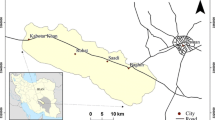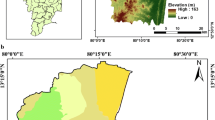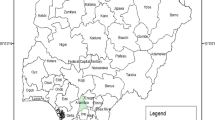Abstract
Developing a reliable groundwater vulnerability and contamination risk map is very important for groundwater management and protection. This study aims to compare various modified DRASTIC vulnerability frameworks based on rate calibration using the Wilcoxon rank-sum test (WRST), frequency ratio (FR) and weight optimization using the correlation coefficient (CC), the analytic hierarchy process (AHP), and genetic algorithms (GA), as well as to introduce, for the first time, an aggregated approach based on a bagging ensemble to develop a combined modified DRASTIC model. This research was conducted in the Khoy plain, NW Iran. To develop a typical DRASTIC map, seven DRASTIC data layers were generated, weighted, and then overlaid in ArcGIS. The nitrate (NO3) concentrations at 54 sites in the study area were used to validate the models by calculating the correlation coefficient (r) between the vulnerability/risk indices and NO3 concentrations. The calculated r value for the typical DRASTIC was 0.12. A sensitivity analysis reveals that the impact of the vadose zone and conductivity parameters with mean variation indices of 22.2 and 7.5%, respectively, have the highest and lowest influence on aquifer vulnerability. The r values increased for all the optimized frameworks. The results show that the WRST and GA methods are the most effective methods for calibration and optimization of DRASTIC rates and weights, with the WRST-GA-DRASTIC model obtaining an r value of 0.64. A bagging ensemble model was employed to combine the advantages of each standalone model. The bagging ensemble model yields an r value of 0.67. The ensemble model has the potential to increase the r value further than both the standalone optimized frameworks and the typical DRASTIC approach. In terms of spatial distribution class area (%), the bagging ensemble-DRASTIC model demonstrates that the moderate and low contamination risk classes with 16.4 and 23.1% of the total area cover the lowest and highest parts of the plain.






Similar content being viewed by others
References
Aller L, Bennett T, Lehr JH, Petty RJ, Hackett G (1987) DRASTIC: a standardized system for evaluating ground water pollution potential using hydrogeologic settings, EPA 600/2-87-035. Ada, Oklahoma: U.S. Environmental Protection Agency.
Almasri MN (2008) Assessment of intrinsic vulnerability to contamination for Gaza coastal aquifer, Palestine. J Environ Manag 88(4):577–593
APHA (2005) Standard methods for the examination of water and wastewater, 17th edn. American Public Health Association, Washington
Aydogmus¸ HY, Ekinci A, Erdal HI, Erdal H (2015) Optimizing the monthly crude oil price forecasting accuracy via bagging ensemble models. J Econ Int Finance 7(5):127–136
Barutçuoğlu Z, Alpaydin E (2003) A comparison of model aggregation methods for regression. In: Kaynak O, Alpaydın E, Oja E, Xu L (eds.) ICANN/ICONIP 2003. LNCS, vol. 2714, pp. 76–83. Springer, Heidelberg.
Barzegar R, Asghari Moghaddam A, Kazemian N (2015) Assessment of heavy metals concentrations with emphasis on arsenic in the Tabriz plain aquifers, Iran. Environ Earth Sci 74(1):297–313
Barzegar R, Asghari Moghaddam A, Tziritis E (2016a) Assessing the hydrogeochemistry and water quality of the Aji-Chay River, northwest of Iran. Environ Earth Sci 75(23):1486
Barzegar R, Asghari Moghaddam A, Baghban H (2016b) A supervised committee machine artificial intelligent for improving DRASTIC method to assess groundwater contamination risk: a case study from Tabriz plain aquifer. Iran Stoch Environ Res Risk Assess 30(3):883–899
Barzegar R, Asghari Moghaddam A, Najib M, Kazemian N, Adamowski J (2016c) Characterization of hydrogeologic properties of the Tabriz plain multi-layer aquifer system. NW Iran Arab J Geosci 9(2):1–17
Barzegar R, Fijani E, Moghaddam AA, Tziritis E (2017) Forecasting of groundwater level fluctuations using ensemble hybrid multi-wavelet neural network-based models. Sci Total Environ 599:20–31
Barzegar R, Moghaddam A, Deo R, Fijani E, Tziritis E (2018) Mapping groundwater contamination risk of multiple aquifers using multi-model ensemble of machine learning algorithms. Sci Total Environ 621:697–712
Camacho-Navarro J, Ruiz M, Villamizar R, MujicaL, Moreno-Beltrán G (2017) Ensemble learning as approach for pipeline condition assessment. IOP Conf Series: Journal of Physics: Conf Series 842:842–012019. https://doi.org/10.1088/1742-6596/842/1/012019
Chen JJ, Tsai CA, Moon H, Ahn H, Young JJ, Chen CH (2006) Decision threshold adjustment in class prediction. SAR QSAR Environ Res 17(3):337–352
Civita M (1994) Aquifer vulnerability maps to pollution. Pitagora Ed, Bologna
Civita M, DeRegibus C (1995) Sperimentazione di alcune metodologie per la valutazione della vulnerabilita degli aquifer. Q Geol Appl Pitagora Bologna 3:63–71
Daly D, Dassargues A, Drew D, Dunne S, Goldscheider N, Neale S, Popescu C, Zwhalen F (2002) Main concepts of the “European Approach” for (karst) groundwater vulnerability assessment and mapping. Hydrogeol J 10(2):340–345
Doerfliger N, Zwahlen F (1997) EPIK: a new method for outlining of protection areas in karstic environment, In: International symposium and field seminar on “karst waters and environmental impacts,” edited by: Gunay, G. and Jonshon, AI, Antalya, Turkey, Balkema, Rotterdam 117–123.
Elçi A (2017) Calibration of groundwater vulnerability mapping using the generalized reduced gradient method. J Contam Hydrol 207:39–49
Erdal H, Karahanoglu I (2016) Bagging ensemble models for bank profitability: an empirical research on Turkish development and investment banks. Appl Soft Comput 49:861–867
Erdal HI, Karakurt O (2013) Advancing monthly streamflow prediction accuracy of CART models using ensemble learning paradigms J. Hydrol 477:119–128
Fakhri MS, Asghari Moghaddam A, Najib M, Barzegar R (2015) Investigation of nitrate concentrations in groundwater resources of Marand plain and groundwater vulnerability assessment using AVI and GODS methods. J Environ Stud 41(1):49–66
Foster SSD (1987) Fundamental concepts in aquifer vulnerability, pollution risk and protection strategy. In: Van Duijvenbooden W, Waegeningh HG (Eds.), TNO Committee on Hydrological Research, the Hague. Vulnerability of Soil and Groundwater to Pollutants, Proc. Inf. 38, pp. 69–86.
Gheisari N (2017) Groundwater vulnerability assessment using a GIS-based modified DRASTIC model in agricultural areas. Master thesis, Department of Civil Engineering, University of Ottawa.
Gogu RC, Dassargues A (2000) Current trends and future challenges in groundwater vulnerability assessment using overlay and index methods. Environ Geol 39:549–559
Goldscheider N, Klute M, Sturm S, Hotzl H (2000) The PI method – a GIS-based approach to mapping groundwater vulnerability with special consideration of karst aquifers. Z Angew Geol 46(3):157–166
Holland J (1975) Adaptation in natural and artificial systems. University of Michigan Press, Ann Arbor, p 228
Huan H, Wang J, Teng Y (2012) Assessment and validation of groundwater vulnerability to nitrate based on a modified DRASTIC model: a case study in Jilin City of northeast China. Sci Total Environ 440:14–23
Jafari SM, Nikoo MR (2016) Groundwater risk assessment based on optimization framework using DRASTIC method. Arab J Geosci 9:742. https://doi.org/10.1007/s12517-016-2756-4
Jang CS, Lin CW, Liang CP, Chen JS (2016) Developing a reliable model for aquifer vulnerability. Stoch Env Res Risk A 30(1):175–187
Kang J, Zhao L, Li R, Mo H, Li Y (2017) Groundwater vulnerability assessment based on modified DRASTIC model: a case study in Changli County, China. Geocarto Int 32(7):749–758
Kazakis N, Voudouris KS (2015) Groundwater vulnerability and pollution risk assessment of porous aquifers to nitrate: modifying the DRASTIC method using quantitative parameters. J Hydrol 525:13–25
Kralik M, Keimel T (2003) Time-input, an innovative groundwater-vulnerability assessment scheme: application to an alpine test site. Environ Geol 44(6):679–686
Liang CP, Jang CS, Liang CW, Chen JS (2016) Groundwater vulnerability assessment of the Pingtung Plain in Southern Taiwan. Int J Environ Res Public Health 13(11):1167
Nabavi MH (1976) An introduction to geology of Iran. Geological survey of Iran, Tehran (in Persian).
Navulur KC (1996) Groundwater vulnerability evaluation to nitrate pollution on a regional scale using GIS (Unpublished Doctoral dissertation) Purdue University, Indiana.
Neshat A, Pradhan B (2015) An integrated DRASTIC model using frequency ratio and two new hybrid methods for groundwater vulnerability assessment. Nat Hazards 76:543–563
Neshat A, Pradhan B, Pirasteh S, Shafri HZM (2014) Estimating groundwater vulnerability to pollution using a modified DRASTIC model in the Kerman agricultural area, Iran. Environ Earth Sci 71(7):3119–3131
Neshat A, Pradhan B, Dadras M (2016) Groundwater vulnerability assessment using an improved DRASTIC method in GIS. Resour Conserv Recycl 86:74–86
Pacheco FAL, Pires LMGR, Santos RMB, Sanches Fernandes LF (2015) Factor weighting in DRASTIC modeling. Sci Total Environ 505:474–486
Panagopoulos GP, Antonakos AK, Lambrakis NJ (2006) Optimization of the DRASTIC method for groundwater vulnerability assessment via the use of simple statistical method and GIS. Hydrogeol J 14(6):894–911
Pathak DR, Hiratsuka A, Awata I, Chen L (2009) Groundwater vulnerability assessment in shallow aquifer of Kathmandu Valley using GIS-based DRASTIC model. Environ Geol 57:1569–1578
Petelet-Giraud E, Doerfliger N, Crochet P (2000) RISKE: méthode d’évaluation multicritère de la cartographie de la vulnérabilité des aquifères karstiques. Application aux systèmes des Fontanilles et Cent-Fonts (Herault, Sud de la France). Hydrogeologie 4:71–88
Piscopo G (2001) Groundwater vulnerability map explanatory notes: MacIntyre Catchment. NSW Department of Land and water Conservation, Sydney, p 13
Saaty TL (1977) A scaling method for priorities in hierarchical structures. J Math Psychol 15(3):234–281
Saaty TL (1980) The analytic hierarchy process: planning, priority setting, resource allocation. McGraw-Hill, New York
Sadat-Noori M, Ebrahimi K (2016) Groundwater vulnerability assessment in agricultural areas using a modified DRASTIC model. Environ Monit Assess 188(1):19
Sahoo S, Dhar A, Kar A, Chakraborty D (2016) Index-based groundwater vulnerability mapping using quantitative parameters. Environ Earth Sci 75(6):1–13
Salkind NJ (2010) Encyclopedia of research design Thousand Oaks. SAGE Publications Ltd, CA. https://doi.org/10.4135/9781412961288.
Sener E, Davraz A (2012) Assessment of groundwater vulnerability based on a modified DRASTIC model, GIS and an analytic hierarchy process (AHP) method: the case of Egirdir Lake basin (Isparta, Turkey). Hydrogeol J 21:701–714
Sivanandam SN, Deepa SN (2008) Introduction to genetic algorithms. Springer, Berlin
Soltani S, Asghari Moghaddam A, Barzegar R, Kazemian N, Tziritis E (2017) Hydrogeochemistry and water quality of the Kordkandi-Duzduzan plain, NW Iran: application of multivariate statistical analysis and PoS index. Environ Monit Assess 189:455
Stigter TY, Ribeiro L, Carvalho Dill AMM (2006) Evaluation of an intrinsic and a specific vulnerability assessment method in comparison with groundwater salinisation and nitrate contamination levels in two agricultural regions in the south of Portugal. Hydrogeol J 14:79–99
Thirumalaivasan D, Karmegam M, Venugopal K (2003) AHP-DRASTIC: software for specific aquifer vulnerability assessment using DRASTIC model and GIS. Environ Model Softw 18:645–656
USDA (United States Department of Agriculture) (1994) Permeability Key. http://www.mn.nrcs.usda.gov/mo10/ mo10guides/permkey. Accessed 1 October 2011.
Van Stempvoort D, Ewert L, Wassenaar L (1993) Aquifer vulnerability index (AVI): a GIS compatible method for groundwater vulnerability mapping. Can Water Res J 18:25–37
Vrba J, Zoporozec A (1994) Guidebook on mapping groundwater vulnerability. International Contributions to Hydrogeology. Verlag Heinz Heise GmbH and Co. KG.
Wilcoxon F (1945) Individual comparisons by ranking methods. Biom Bull 1(6):80–83. https://doi.org/10.2307/3001968
World Health Organization (WHO) (2011) Guidelines for drinking-water quality. WHO Press, Switzerland
Yang J, Tang Z, Jiao T, Muhammad AM (2017) Combining AHP and genetic algorithms approaches to modify DRASTIC model to assess groundwater vulnerability: a case study from Jianghan Plain. China Environ Earth Sci 76:426
Acknowledgements
The authors are greatly appreciative to the Iran Ministry of Science, Research and Technology for providing Rahim Barzegar a scholarship for conducting this research at McGill University, under the supervision of Professor J. Adamowski.
Author information
Authors and Affiliations
Corresponding author
Additional information
Responsible editor: Marcus Schulz
Publisher’s note
Springer Nature remains neutral with regard to jurisdictional claims in published maps and institutional affiliations.
Rights and permissions
About this article
Cite this article
Barzegar, R., Asghari Moghaddam, A., Adamowski, J. et al. Delimitation of groundwater zones under contamination risk using a bagged ensemble of optimized DRASTIC frameworks. Environ Sci Pollut Res 26, 8325–8339 (2019). https://doi.org/10.1007/s11356-019-04252-9
Received:
Accepted:
Published:
Issue Date:
DOI: https://doi.org/10.1007/s11356-019-04252-9




